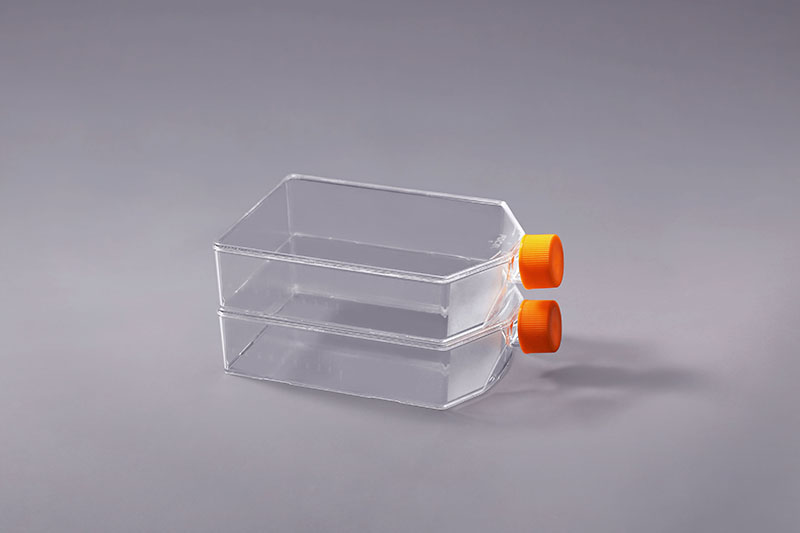نوعی مواد مصرفی کشت سلولی از نوع بطری است. به منظور ارتقای عملکرد چسبندگی سلول ها، مواد مصرفی هنگام کشت سلول های اولیه پوشش داده می شوند. بافر پوششی رایج شامل موارد زیر است:Polylysine: این یک ترکیب مصنوعی، یک اسید آمینه با بار مثبت است که با تغییر الکترود روی سطح بستر کشت، چسبندگی سلول را افزایش میدهد. این به طور گسترده ای در کشت سلولی برای پوشش هایی برای تقویت چسبندگی سلولی استفاده می شود. علاوه بر تقویت چسبندگی و رشد سلولی، پوشش پلی لیزین با محلول پوششی می تواند میزان بقای سلول های اولیه را افزایش داده و رشد نوریت را افزایش دهد. فلاسک کشت سلولی
فیبرونکتین: این یک گلیکوپروتئین با مولکولی بالا است که در سال 1974 در خارج از کشور تحقیق و کشف شد. و دارای عملکردهای بیولوژیکی متنوعی است. فیبرونکتین یک گلیکوپروتئین با وزن مولکولی 440-500 کیلو دالتون است. در پروتئین های سطح سلولی و پلاسما یافت می شود. با گیرندههای سطح غشای سلولی و اجزای ماتریکس خارج سلولی ترکیب میشود تا چسبندگی و رشد سلولی را تقویت کند.
ژلاتین: مخلوطی از پروتئینهای محلول در آب با وزن مولکولی بالا مشتق شده از کلاژن، محلول ژلاتین مایع پوششی 0.2 درصد برای پوشش رگهای کشت استفاده میشود. برای تقویت چسبندگی سلولی سلول های بنیادی جنینی انسان را برای تمایز، سلول های اولیه خاص و سلول های جاودانه معرفی کنید. انتخاب خاص بافر پوشش بستگی به نوع و ویژگی های سلول دارد. البته باید توجه داشت که فاصله بین پوشش و استفاده از بطری نباید بیشتر از یک روز باشد. هرچه ظرف پوشش دار بیشتر نگهداری شود، عملکرد چسبندگی آن تحت تأثیر قرار می گیرد.
Gelatin: a mixture of high molecular weight water-soluble proteins derived from collagen, 0.2% coating liquid gelatin solution is used to coat culture vessels to promote cell adhesion. Introduce human embryonic stem cells for differentiation, certain primary cells and immortalized cells.
The above are several coating buffer commonly used in cell culture flasks. The specific choice of coating buffer depends on the type and characteristics of the cells. However, it should be noted that the interval between coating and use of the bottle should not exceed one day. The longer the coated container is stored, its adhesion performance will be affected.
The FAI climbed 5.9 percent year-on-year in the first 11 months of 2018, quickening from the 5.7-percent growth in Jan-Oct, the National Bureau of Statistics (NBS) said Friday in an online statement.
The key indicator of investment, dubbed a major growth driver, hit the bottom in August and has since started to rebound steadily.
In the face of emerging economic challenges home and abroad, China has stepped up efforts to stabilize investment, in particular rolling out measures to motivate private investors and channel funds into infrastructure.
Friday's data showed private investment, accounting for more than 60 percent of the total FAI, expanded by a brisk 8.7 percent.
NBS spokesperson Mao Shengyong said funds into weak economic links registered rapid increases as investment in environmental protection and agriculture jumped 42 percent and 12.5 percent respectively, much faster than the average.
In breakdown, investment in high-tech and equipment manufacturing remained vigorous with 16.1-percent and 11.6-percent increases respectively in the first 11 months. Infrastructure investment gained 3.7 percent, staying flat. Investment in property development rose 9.7 percent, also unchanged.
 English
English



















































